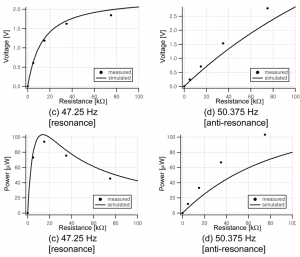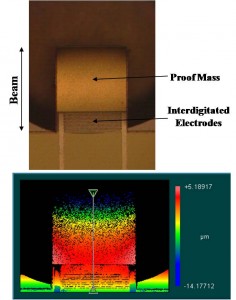Model-based Design of MEMS Vibration-energy-harvesters for Wireless Sensors
The recent development of “low power” (10s-100s of μW) sensing and data transmission devices, as well as protocols with which to connect them efficiently into large, dispersed networks of individual wireless nodes, has created a need for a new kind of power source. Embeddable, non-life-limiting power sources are being developed to harvest ambient environmental energy available as mechanical vibrations, fluid motion, radiation, or temperature gradients. While potential applications range from building climate control to homeland security, the application pursued most recently has been that of structural health monitoring (SHM), particularly for aircraft. This SHM application and the power levels required favor the piezoelectric harvesting of ambient vibration energy. Current work focuses on harvesting this energy with MEMS resonant structures of various geometries. Coupled electromechanical models for uniform beam structures have been developed to predict the electrical and mechanical performance obtainable from ambient vibration sources. The optimized models have been verified by comparison to tests on a macro-scale device both without [1] and with a proof mass at the end of the structure (Figure 1) [2]. A non-optimized, uni-morph beam prototype (Figure 2) has been designed and fabricated [3] [4]. Design tools to allow device optimization for a given vibration environment have been under detailed investigation considering various geometries of the device structures and fabrication constraints, especially in microfabrication. Future work will focus on fabrication and testing of optimized unimorph beams for not only the {3-1} mode but also the {3-3} mode of operation using an interdigitated electrode configuration. System integration and development, including modeling the power electronics, will be included.
- Figure 1: Model predictions vs. experimental results: voltage (upper) and power (lower) vs. varying electrical load resistance at resonance and anti-resonance [2].
- Figure 2: Top-down views of fabricated cantilevered MEMS piezoelectric harvester. An SEM of a prototype uni-morph energy-harvester device (upper) and ZYGO image of the same device (lower) for curvature measurement.
References
- N.E. duToit and B.L. Wardle, “Experimental verification of models for microfabricated piezoelectric vibration energy harvesters,” AIAA Journal, vol. 45, no. 5, May 2007. [↩]
- M. Kim, M. Hoegen, J. Dugundji, and B. L. Wardle. “Modeling and experimental verification of proof mass effects on vibration energy harvester performance,” Smart Mater. Struct., vol. 19, 045023, 2010. [↩] [↩]
- N.E. duToit, B.L. Wardle, and S.-G. Kim, “Design considerations for MEMS-scale piezoelectric mechanical vibration energy harvesters,” Integrated Ferroelectrics, vol. 71, pp. 121-160, 2005. [↩]
- N.E. duToit and B.L. Wardle, “Performance of microfabricated piezoelectric vibration energy-harvesters,” Integrated Ferroelectrics, vol. 83, pp.13-23, 2006. [↩]

